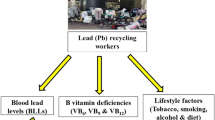Abstract
Occupational and environmental aluminum (Al) exposure cause serious health problems by interaction with biological systems. Al is one of the most documented metals because its cellular targets are unclear biochemical processes and membranes of organisms. The major aim of the present study was to investigate the alteration of serum and urine aluminum in occupational exposure and to observe whether the metal exposure could cause any changes in pteridine-pathway-related critical compounds such as urinary neopterin and biopterin and blood dihydropteridine reductase (DHPR). In this study, determination of the metal concentrations was carried out in Al-exposed workers (n=23) and healthy volunteers (n=18) by using a tomic absorption spectrometer. DHPR enzyme activity and levels of neopterin and biopterin were detected by spectrophotometric and high-performance liquid chromatographic methods, respectively. It was found that occupational exposure to the metal led to a statistically significant increase in serum Al levels compared to the controls (p<0.05). At the same time, urinary neopterin and biopterin concentrations of the exposed group were higher than nonexposed subjects (both p<0.05). The correlations among Al levels and DHPR activity, magnesium concentration in serum and urine, working years, smoking status, and age were evaluated.
Similar content being viewed by others
References
P. O. Ganrot, Metabolism and possible health effects of aluminium, Environ. Health Perspect. 65, 363–441 (1986).
P. Nayak, Aluminum: impacts and disease, Environ. Res. 89, 101–115 (2002).
A. Lione, Aluminum toxicology and the aluminum-containing medications, Pharm. Ther. 29, 255–285 (1985).
R. A. Yokel and P. J. McNamara, Aluminium toxicokinetics: an updated minireview, Pharmacol. Toxicol. 88, 159–167 (2001).
IPCS, Environmental Health Criteria 194: Aluminium, WHO, Geneva (1997).
C. D. Klaassen, Casarette & Doull's Toxicology, The Basic Science of Poisons, 6th ed., McGraw-Hill, New York (2001).
R. Duffin, P. S. Gilmour, R. P. Schins, et al., Aluminium lactate treatment of DQ12 quartz inhibits its ability to cause inflammation, chemokine expression, and nuclear factorkappaB activation, Toxicol. Appl. Pharmacol. 176, 10–17 (2001).
M. S. Golub, P. T. Takeuchi, M. E. Gershwin, and S. H. Yoshida, Influence of dietary aluminum on cytokine production by mitogen-stimulated spleen cells from Swiss Webster mice, Immunopharmacol. Immunotoxicol. 15, 605–619 (1993).
C. Tzanno-Martins, L. S. Azevedo, N. Orii, et al., The role of experimental chronic renal failure and aluminium intoxication in cellular immune response, Nephrol. Dial. Transplant. 11, 474–480 (1996).
H. Wachter, D. Fuchs, A. Hausen, G. Reibnegger, and E. R. Werner, Neopterin as marker for activation of cellular immunity: immunologic basis and clinical application, Adv. Clin. Chem. 27, 81–141 (1989).
H. Wachter, D. Fuchs, A. Hausen, et al., Neopterin Biochemistry: Methods of Clinical Application, de Gruyter, Berlin (1992).
C. Murr, L. C. Fuith, B. Widner, B. Wirleitner, G. Baier-Bitterlich, and D. Fuchs, Increased neopterin concentrations in patients with cancer: indicator of oxidative stress? Anticancer Res., 19, 1721–1728 (1999).
A. Niederwieser and H. C. Curtius, Tetrahydrobiopterin biosynthetic pathway and deficiency, Enzyme 38, 302–311 (1987).
H. Shintaku, A. Niederwieser, W. Leimbacher, and H. C. Curtius, Tetrahydrobiopterin deficiency: assay for 6-pyruvoyl-tetrahydropterin synthase activity in erythrocytes, and detection of patients and heterozygous carries. Eur. J. Pediatr., 147, 15–19 (1988).
Z. Z. Altindag, G. Sahin, F. Inanici, and Z. Hascelik, Urinary neopterin excretion and dihydropteridine reductase activity in rheumatoid arthritis, Rheumatol. Int. 18, 107–111 (1998).
Z. Z. Altindag, G. Sahin, A. Isimer, A. Akpek, and Z. Hascelik, Dihydropteridine reductase activity and urinary neopterin levels in leukemias and lymphomas: is there any correlation between these two parameters? Leuk. Lymphoma 35, 367–374 (1999).
T. Baydar, A. Papp, A. Aydin, etal., Accumulation of aluminum in rat brain, Biol. Trace Element Res. 92, 231–244 (2003).
J. Harris, B. B. Bartelson, E. Barker, R. Balkissoon, K. Kreiss, and L. S. Newman, Serum neopterin in chronic beryllium disease, Am. J. Ind. Med. 32, 21–26 (1997).
Z. Z. Altindag, T. Baydar, A. Isimer, and G. Sahin, Neopterin as a new biomarker for the evaluation of occupational exposure to silica, Int. Arch. Occup. Environ. Health 76, 318–322 (2003).
W. Schobersberger, G. Hoffmann, P. Hobisch-Hagen, et al., Neopterin and 7,8-dihydroneopterin induce apoptosis in the rat alveolar epithelial cell line L2, FEBS Lett. 397, 263–268 (1996).
I. Smith, D. W. Howells, and K. Hyland, Pteridines and mono-amines: relevance to neurological damage, Postgrad. Med. J. 62, 113–123 (1986).
R. J. Leeming, and J. A. Blair, Dialysis dementia aluminium, and tetrahydrobiopterin metabolism, Lancet 1 (8115), 556 (1979).
P. Altmann, F. Al-Salihi, K. Butter, et al., Serum aluminium levels and erythrocyte dihydropteridine reductase activity in patients on hemodialysis. N. Engl. J. Med., 317, 80–84 (1987).
S. M. Sprague and J. G. Umans, Aluminum and dihydropteridine reductase in dialysis patients, N. Engl. J. Med. 317, 1604 (1987).
S. Milstien and S. Kaufman, Letter to the editor, N. Engl. J. Med. 317, 1605 (1987).
P. Altmann, U. Dhanesha, C. Hamon, J. Cunningham, J. Blair, and F. Marsh, Disturbance cerebral function by aluminium in haemodialysis patients without overt aluminium toxicity, Lancet 2 (8653), 7–12 (1989).
I. Smith and K. Hyland, Disturbance of cerebral function by aluminium in haemodialysis patients, Lancet 2(8661), 501–502 (1989).
K. I. Bolla, S. Milstien, G. Briefel, L. Wieler, and S. Kaufman, Dihydropteridine reductase activity: lack of association with serum aluminium levels and cognitive functioning in patients with end-stage renal disease, Neurology 41, 1806–1809 (1991).
K. A. Winship, Toxicity of aluminium: a historical review, Part 2. Toxicol. Rev. 12, 177–211 (1993).
Author information
Authors and Affiliations
Rights and permissions
About this article
Cite this article
Baydar, T., Engin, A.B., Aydin, A. et al. Effect of aluminum exposure on pteridine metabolism. Biol Trace Elem Res 106, 153–164 (2005). https://doi.org/10.1385/BTER:106:2:153
Received:
Revised:
Accepted:
Issue Date:
DOI: https://doi.org/10.1385/BTER:106:2:153




